Abstract
The authors analyse in the article diplomatic techniques and tools used by different states in the domestic and foreign policy aimed at preserving the human resources. The study of the activities of the large military-political groups and military blocs showed how the arms race was accelerated and how the aggressive policy was carried out with the use of the armed force, and thus the atmosphere of the mutual mistrust and suspicion thickened. The authors, using the method of the cognitive modelling and building the cognitive maps, showed the connections in the analysed social practices from the standpoint of the means of the diplomatic pressure used by the diplomats and intelligence officers to achieve the goals in the foreign and domestic political spheres of the state influence. In the study, the authors analysed the social practices associated with the options for using the diplomatic tools in solving fateful issues related to the foreign and domestic policies of the large states in the world space and clearly showed through the cognitive modelling the interconnection of the components associated with the political decisions aimed at reducing the risks of the potentially dangerous situations leading to emergencies of war and peacetime.
Keywords: Cognitive modelling, diplomatic techniques and methods, intellectual wars, military-political alliances, human resources
Introduction
The intellectual wars have long been fought through the diplomacy, which is an invisible battle for the interests of the powers with the help of the parliamentarians and negotiators. The phenomenon of the diplomacy is complex and even contradictory in many of its manifestations. Analysing the historical and political views, it can be argued with conviction that the understanding of the nature of the diplomacy is broad and not always consistent. The diplomacy was and is now an indisputable effective instrument for ensuring the national security of the states. On how secretly and without disclosing their plans to find out the intentions of their potential opponents, to conclude a profitable political alliance in many respects, on which the peaceful coexistence of this or that state entirely depended. In the study, the authors analysed the social practices associated with the options for using the diplomatic tools in solving fateful issues related to the foreign and domestic policies of the large states in the world space and clearly showed through the cognitive modelling the interconnection of the components associated with the political decisions aimed at reducing the risks of the potentially dangerous situations leading to emergencies of war and peacetime.
Problem Statement
The study focuses on the analysis of the phenomenon of intellectual wars and diplomatic techniques, as well as the tools used by states in domestic and foreign policy and aimed at preserving human resources. Intellectual wars in the modern world cover the spheres of human activity, where there are situations of confrontation, mutual mistrust and the implementation of hostile plans in relation to each other. In the work, the authors, using the method of cognitive modelling, which, when making decisions, helps them to fix their representation of a problem situation in the form of a formal model, build cognitive maps, which in turn contributes to the display of connections in the analysed social practices from the standpoint of studying the means of diplomatic pressure used by diplomats and intelligence officers to achieve goals in the foreign and domestic political spheres of influence. Using cognitive modelling, the authors identify the interconnection of components associated with political decisions aimed at reducing risks in potentially dangerous situations.
Research Questions
1. Analyze the diplomatic practice, mechanisms and tools used by Russian diplomats in different historical periods in order to further conduct cognitive analysis and build cognitive maps based on a comparative study of historical facts, successful techniques and means of conducting the secret diplomacy.
2. Show the examples of the use of the diplomatic means and options for diplomatic influence in the foreign and domestic policies of states in various historical perspectives.
3. Build a cognitive model of the system "Instruments (techniques) of Russian and US diplomacy as a means of waging intellectual wars" using cognitive modeling procedures.
4. Show that modern diplomatic instruments of Russia and the policy of the state in general are aimed at the peaceful settlement of potential conflict situations and reducing the risks associated with them.
Purpose of the Study
At the beginning, let us say that for our study it will be interesting to note G. Nicholson, who in the monograph "Diplomacy" pointed out that there were the real catastrophes and the potential risks associated with the fact that the representatives of a particular country did not have full support from the side of their highest authority (Nicholson, 1941). Moreover, the illustration of the diplomatic activity can be the sharp phrase of Louis XI, who told the ambassadors: "If they lie to you, lie even more" (Worth, 2011).
So, the diplomatic practice, mechanisms and tools used by the Russian diplomats in different historical periods were analysed during the study with the aim to conduct the cognitive analysis and to build the cognitive maps based on the comparative study of the historical facts, the successful techniques and the means of the secret diplomacy.
It is known that only in the 18th century during of the reign of Peter I, the diplomacy turned into a "regular" government service. As Kudryavtsev (2002) correctly noted, the usual method of the diplomats was to overestimate the requirements at the initial stage of the negotiations to achieve what they wanted at the end.
During the reign of Nicholas I, the police point of view prevailed in Russia, in other words, the concern for the maintenance of the order and the strict discipline, or rather the coercive nature of the relations on many key issues. Based on this premise, it can be argued that the diplomatic activity of the sovereign of the Russian Empire was based, on the one hand, on the ability to negotiate and to understand the mistake and turn off the dangerous path, and on the other hand, on the stick discipline and the regime of the gendarme strangling of the press, art, literature and science. As Tarle (2018) pointed out, according to the views of Nicholas I, the Russian Empire was created by the conquests, and the physical strength alone subordinated the entire conglomerate of the subjects to was he unlimited power of the Russian Tsar. The following remark about the reign of Nicholas I - all revolutions came from the weakness and the condescension of the rulers, any concession was disastrous. From this follows the idea of the sovereign about the serfdom, the question that was too dangerous to raise and that it was better to put up with anything, but not touch the foundations of the existing order of things (Tarle, 2018). In general, it can be stated that during the period under review, the Russian diplomacy set itself the task of having the control over the straits, getting rid of the serious danger that England posed, and securing all the Russian Black Sea coasts and the freedom of export.
Let us give separately a variant of the search for the solution undertaken by A.F. Orlov (as cited in Tarle, 2018). He, through the threats and pressure using the diplomatic method, without shedding a drop of the Russian blood, forced the Turkish troops to leave the Taurus ridge, and as a result, the Turkish troops in full force left the Taurus and on July 8, 1833, and the new Russian-Turkish agreement was signed by Orlov and Turkish representatives.
As a counterbalance, let us give a variant of the American diplomatic policy. Thus, the US President Thomas Roosevelt and his “big stick” diplomacy, which was well known to all states, were effectively supplemented by the power of the dollar. In practice, the US government also resorted to the means of the pressure. The example is the American diplomacy, which constantly interfered in the Cuba's affairs and the threatened reprisals, and as a result, the American troops remained in the Cuban Republic until January 1909. Here, there was clearly a connection between the political pressure of the United States, ensuring the expansion of the American capital and the diplomacy pushed the way for the dollar, and the dollar, in turn, facilitated the work of the diplomacy and the military. Following Cuba, Panama and the Dominican Republic, Nicaragua, Haiti, and then the other Central American countries became the victims of the dollar diplomacy. Later, by the time of the First World War, Mexico fell the victim to the US armed intervention.
In turn, the example of the use of the diplomatic means by the Russian government was the situation that developed in the relations with Turkey in 1914, during the Russia's struggle for Constantinople and the Black Sea straits of the Bosporus and Dardanelles. Note that for the Russian Empire, the issue of controlling the straits was one of the most urgent points of the foreign policy. It is known that Nicholas II, in order to put the pressure on Turkey, approved the joint decision of the Minister of the Foreign Affairs S. D. Sazonov, the Minister of the War and the Minister of the Sea “in the event of the major European war, to resolve the “eastern issue” in favour of Russia by establishing the dominance in Constantinople, the Bosporus and the Dardanelles” (Gottlieb, 1960). Since the Russian Empire had the right to keep the Black Sea Fleet, however, it could not take it out of the water area of this reservoir due to the closed regime of the straits. So, a significant result of the activities of the Minister of the Foreign Affairs of Russia S.D. Sazonov as a diplomat was the agreement with England and France in 1915 that after the victorious end of the world war the Black Sea and Constantinople would pass to Russia. However, the Soviet Russia refused to take the part in the partition of Turkey.
In this context, another example of the diplomatic tool can serve as the statement of J. Buchanan (as cited in Adamov, 1925), calculated for the propaganda effect in Russia itself, there are many reasons to believe that the war with Turkey should be met with sympathy by wide circles of the Russian public, convinced that Russia will not derive any significant benefits from wars with Germany and Austria. Moreover, in practice, the opinion of the highest circles of Russian society was reduced to unanimity on the issue of annexing the capital of the Sultan and exits from the Black Sea to the possessions of Nicholas II. It should be noted that the strategic interests of Russia in the issue of access to the straits through the Black Sea consisted in the urgent need for a sea trade route for Russia. So, in the memorandum of the Russian diplomat N. A. Basili said: "The dependence of this trade route ... on the arbitrariness of someone else's territorial power ... contradicts our primary state interests" (as cited in Adamov, 1925, p. 500). This opinion was shared by Professor E.N. Trubetskoy, who belonged to the Liberal Party, Russian Foreign Minister Sazonov, economist Tugan-Baranovsky, P.N. Milyukov, head of the Cadets - the leading bourgeois party, etc. Thus, a considerable contribution to the restoration the status of a power in the world arena was to be brought by the Russian diplomacy, which made all the possible efforts for this.
Further, the diplomatic policy pursued by V. I. Lenin and the Bolsheviks during the First World War. So, as Robert Worth noted, they began to carry out a political campaign for Russia's withdrawal from the war, and the Petrograd Soviet campaigned for the democratic world “without annexations and indemnities” (as cited in Hill, 1905).
The first foreign minister of the Soviet Russia was L.D. Trotsky, who categorically argued that the world proletariat did not need the diplomacy. Moreover, in Smolny the diplomacy was considered a swear word. In the work of the author L. M. Mlechin "The Secret Diplomacy of the Kremlin," the following about Trotsky is said: “The mob listens to Trotsky, goes berserk, burns. Trotsky swears the rabble swears. In a revolution, the crowd demands a pose, an immediate effect. "Let us also cite here the statement of V. I. Lenin "Lie!". The Soviet diplomacy would carry this testament through all the years. Lenin himself considered the diplomacy only a cover for the real politics and explained to the employees of the People's Commissariat: any slogans, even inconsistent with the country's policy, are suitable, as long as they contribute to the decomposition of the enemy (as cited in Mlechin, 2019). In turn, Stalin considered the diplomacy to be the art of the deception brought to perfection according to which the words of a diplomat should not have anything to do with actions otherwise, what kind of diplomacy is this? Words are one thing, but deeds are another ... The sincere diplomacy is impossible (Mlechin, 2019).
"Until a person violates someone else's freedom, coercion cannot take place." - G.V. Chicherin said who led the Soviet diplomacy for the twelve years. However, in the social practices it can be argued that the direct coercion by the government power through the political discipline did not always lead to the desired results. So, already in February 1918, at the meeting of the Central Committee, this idea was probably first voiced in the world politics: "the state is forced to do what the party would not have done."
According to the eyewitness to the work of the Soviet diplomats, in the pre-war period, i.e. before the Second World War P. A. Sudoplatov: the diplomats J. Surits, B. Stein, I. Maisky, carried out the important tasks. However, in the key areas, not professional diplomats were deployed, but the representatives of the People's Commissariat of Internal Affairs intelligence; this is K. A. Umansky in the United States, the ambassador-resident of the People's Commissariat of Internal Affairs A. S. Panyushkin in China. In addition, the extensive work was carried out abroad, for example, the communist parties were viewed as a military reserve in the future military confrontation, as well as the work with the emigration made it possible to reach the valuable sources of the information that secretly shared the ideological views of the Soviet country and, these are the agents of influence (Sudoplatov, 2001). Undoubtedly, the work of the diplomats and the intelligence officers, aimed at exposing the pro-Hitler and anti-Soviet policies, played an important role. Obviously, such activities led to an effective result and an example is the publication in the communist press of materials about the crimes of fascist units in Ethiopia and Spain, made by the journalist J. Tabuy, who was involved in the cooperation with the Soviet Union by the diplomat and intelligence officer M.I. Rosenberg.
It is impossible to ignore the diplomatic work of the adviser of the Soviet embassy in Berlin G.A. Astakhov who made a lot of efforts in the initial stage of the preparing the Soviet-German non-aggression pact and subsequently fell under the repression.
It is quite appropriate to summarize that during the Patriotic and World War II, the Soviet Union regained itself, from the standpoint of the geopolitical conquests and increasing the country's security level, all that weakened Russia lost in 1918-1920. Besides the Soviet Union also took the revenge from Japan for the defeat on the hills of Manchuria, in the Tsushima Strait and near Port Arthur in 1904-1905. (Sakharov, 1995).
The other example is the purely diplomatic coercive pressure, which resulted in the agreements on the mutual assistance with the right to deploy the Soviet troops in the Baltic States, to mobilize their communist supporters in these countries, as well as to exert powerful social and political pressure on their bourgeois leadership. Moreover, the result was the entry of the Baltic States into the USSR.
According to A. N. Sakharov, the diplomatic turn at the beginning of the war was determined primarily by the Soviet people and the army, and the politicians implemented it. And also the position that a characteristic feature of the Soviet diplomacy was that it never had a beginning or an end and never uttered the last word, as well as the fact that it tends to open up prospects against the background of serious defeats (Sakharov, 1995). The diplomacy, with varying degrees of the intensity, found confirmation in the history of the Soviet state. In this context, we can talk about the idea of the propaganda of the communist revolution around the world, which was a kind of the smokescreen of the ideological nature, designed to establish the USSR in the role of a superpower influencing all the events in the world. Although this concept was originally ideological, it gradually became the real political course.
The example of the successful actions of the Soviet diplomatic intelligence was the work carried out against the Western scientists as “the agents of the Soviet intelligence” (Oppenheimer, Fermi, Bohr and others). They weren't. However, they deliberately shared the important information about the scientific and technical developments in the field of the nuclear weapons with the confidants of the Soviet government and intelligence. Their scientific works came to the Soviet Union and Sweden with their knowledge (Sudoplatov, 1997).
Further the relations between the US President J. F. Kennedy and N. S. Khrushchev in settling the Cuban crisis, well-known in the world practice, were based on the open channels for the dialogue. If to look deep into the history of the US diplomacy, it can be noted that the doctrine of "the open doors" was the essential stage in the development of the specific methods of the colonial policy of the United States. Thus, the liberal guise was formed. And thus, under the leadership of the President J.F. Kennedy, the diplomatic policy began to crystallize, based on the tools of "the flexible response", which assumed the United States' readiness for military action in any situations and the nuclear arms race (Dobrynin, 1997). Moreover, there is an opinion that "the Russians can be forced to retreat only if they are sure that the United States is ready to respond with arms to any act of aggression" (Hasanli, 2008, p. 500).
It should be noted that the work of the Soviet diplomats during the period of the confrontation between the two superpowers is reflected in the works of many researchers and eyewitnesses, these are the works of (Erofeev, 2005; Grinevsky, 1998; Israelian, 2006; Kvitsinsky & Kvitsinsky, 2000; Kornienko, 2001; Timerbaev, 2007; Troyanovsky, 1997).
Another variant of the diplomatic and political blackmail in the later period of the history of Russia and the United States and at the present stage is the oil weapon. An interesting opinion is the work of G. Kissinger as a diplomat, politician and strategic analyst, who was appointed by the President R. Nixon to the post of the Assistant for the National Security. It is also important that he was diplomatically able to “put the sword (the oil weapon) back into its scabbard” thus preventing a new bloody war (Kissinger, 2014).
Thus, this article proposes a cognitive model of the system "The instruments (techniques) of the Russian and US diplomacy as the means of the waging intellectual wars" using the procedures of the cognitive modeling.
Research Methods
The article proposes a cognitive model of the system "The instruments (techniques) of the Russian and US diplomacy as the means of the waging intellectual wars" using the procedures of the cognitive modelling.
The composition and interaction of the Blocks "The techniques of tsarist Russia diplomacy" and "The diplomatic activity of the Soviet State", "The diplomacy of the Bolsheviks and the USSR", "The US Diplomacy" which contributed to the expansion of Russia's geopolitical interests, the international role of the Russian autocracy. The diplomacy of the Soviet Russia merged with the political and military intelligence, the recruitment of the allies, the coercive mechanism of the arms race, into which the USSR was dragged into the ball by the United States, the preparation of the armed intervention was entrusted to the imperialist diplomacy of the United States, the wars for the redivision of the world led by the United States.
Let's single out the blocks of factors in the model "The instruments (techniques) of the Russian and US diplomacy as the means of waging the intellectual wars".
The composition of the Block 1. "The diplomatic activities of tsarist Russia". D1 - “The full-fledged support of the activities of the diplomats by the state power”, D2 - “ The overestimation of the requirements”, D3 - “ The police point of view (security and strict discipline)”, D4 - “The physical strength is the way of subordinating the unlimited power of the Russian tsar”, D5 -"The inviolability of the foundations of the existing order - any concession is disastrous".
The composition of the Block 2. "The military diplomacy of tsarist Russia". В1 - "The pressure on Turkey to control the Bosporus and Dardanelles in 1914", В2 - "The closed regime of the Bosporus and Dardanelles", В3 - "Russia's strategic interests – the sea trade route", В4 - "The dependence on the foreign territorial power ", В5 - "The status of the power in the world arena ", В6 - "The First World War with Germany."
Let us single out the blocks of factors in the model "The diplomatic activity of the Soviet state".
The composition of the Block 3. "The diplomacy of the Bolsheviks and the USSR".
A1 - "The Petrograd council for the democratic peace" without annexations and indemnities - the political campaign for the way out of the First World War." A2 - “The Soviet Russia does not participate in the partition of Turkey”. A3 - "L. D. Trotsky - the world proletariat does not need the diplomacy." A4 - “Revolution is the immediate effect”. A5 - "Stalin about the diplomacy: the art of the deception." A6 - "No violation of freedom - no coercion, the principle of the Soviet diplomacy." A7 - “The communist parties are the combat reserve in the future military confrontation” A8 - “The work with the emigration (the agents of influence)”. A9 - “Exposing the pro-Hitler coalition”. A10 - "The pact on the non-aggression of Germany against the USSR." A11 - “The diplomatic pressure in the Baltic states”. A12 - "The deployment of the Soviet troops in the Baltic states." A13 - "The promotion of the communist revolution throughout the world." A14 - "The scientific and technical developments in the field of the nuclear weapons." A15 - “The forced arm race”.
The composition of Block 4. "The US diplomacy". C1 - “The US Open Door Doctrine”. C2 - "The tool - the flexible response", The US readiness for the military action." С3 - "The big stick diplomacy supplemented by the power of the dollar." С4 - “The expansion of the American Capital”. С5 - "The oil weapons".
It is known that a cognitive map is a weighted directed graph (Maksimov, 2002):
G = <V, E>,
where V – graph vertices;
E – graph arcs.
Findings
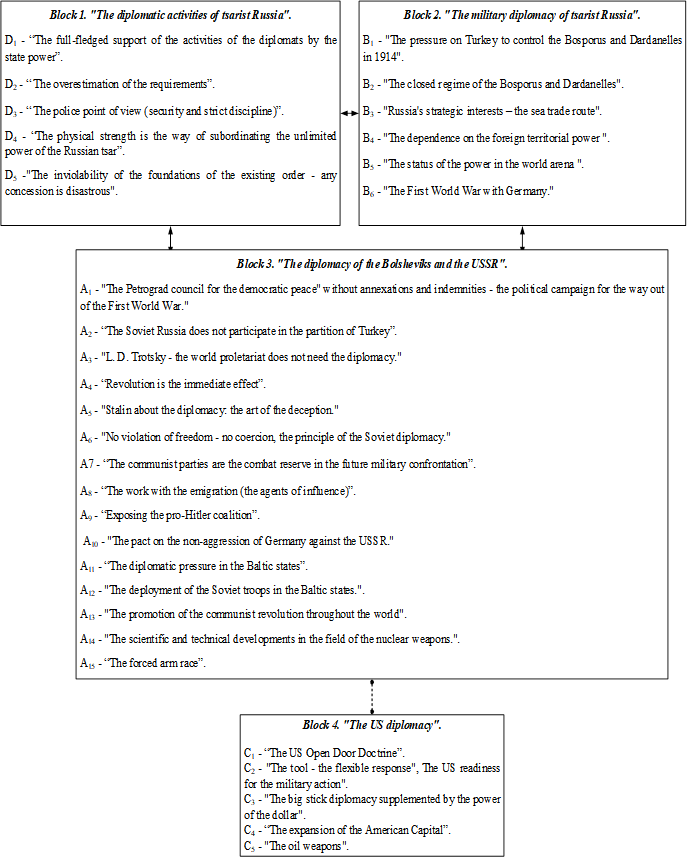
The solid lines and the symbol "1,00" denote a positive relationship between the vertices Vi and Vj (Figures 1-5). That is, the increase (decrease) in the influence of the vertex Vi causes the increase (decrease) in the vertex Vj. The lines and the symbol “–1,00” indicate a negative relationship between Vi and Vj, that is, the increase (decrease) in the influence of the top Vi causes the decrease (increase) in the top Vj (Adamov, 1925).
Figure 1 shows the composition of the blocks and their interaction.
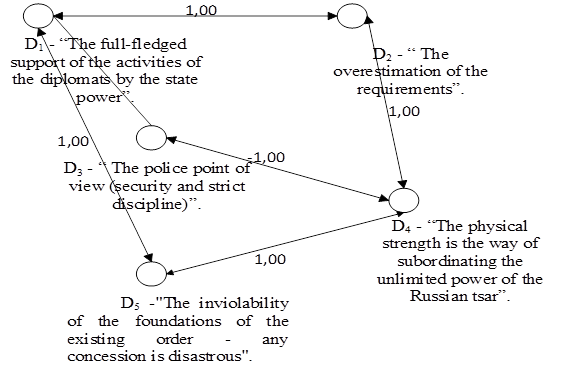
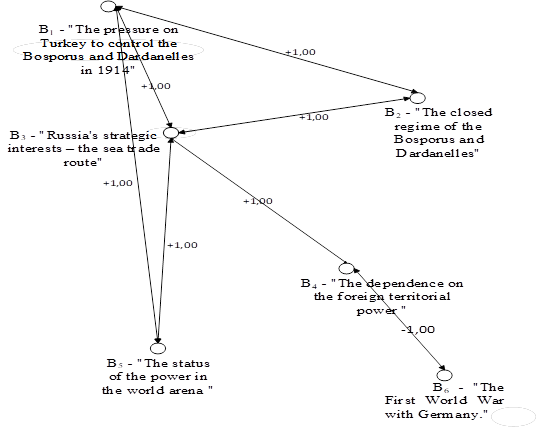
"The instruments (techniques) of the Russian and US diplomacy as the means of the waging the intellectual wars".
Figures 1-5 show the cognitive maps that clearly demonstrate the interconnection of the blocks obtained in the course of the analysis of the social practices related to the use of the diplomatic methods and the tools for solving the external and internal political issues.
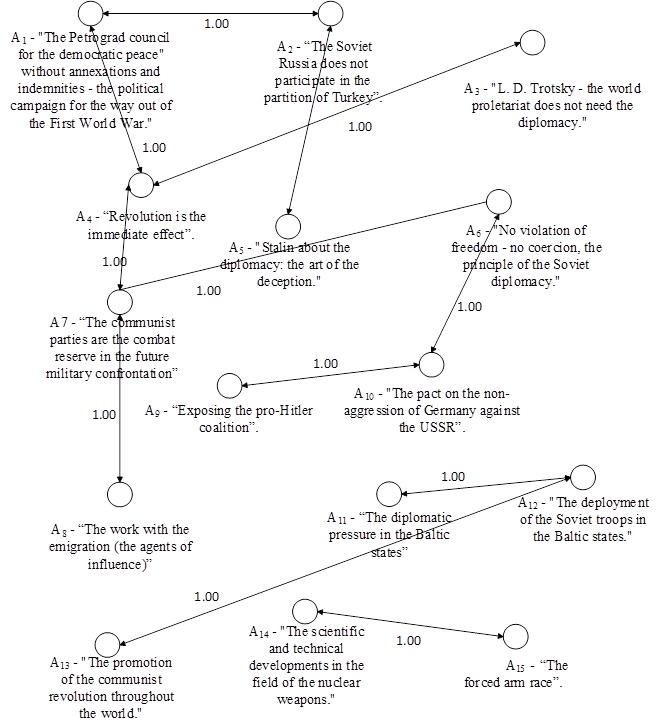
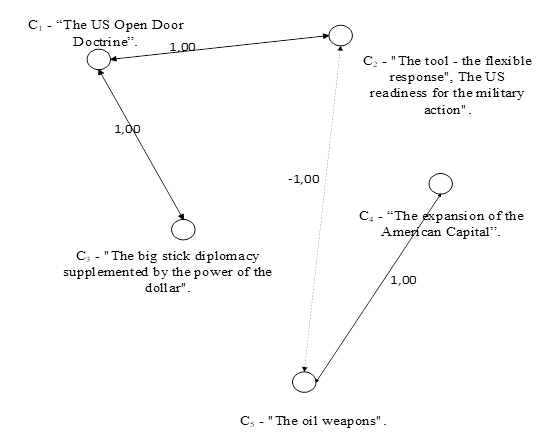
Conclusion
Therefore, in the diplomatic activities of tsarist Russia, the blocks are interconnected as follows: D1, D5, D2 + D2, D3, D4, D5 have the mutual influence on each other, increasing the power of the use of the diplomatic methods and means. In turn, when building the map shown in Figure 3 and associated with the military diplomacy of tsarist Russia, the connection of the blocks looks as follows: B1, B5, B3, B2 + B4, B6, B3 and the blocks have the positive relationship. When constructing the cognitive map related to the analysis of the social practices of the diplomacy of the Bolsheviks and the USSR, we identified the following connections between the blocks: A1, A2, A4, A5 + A3, A6, A7, A10, A8, A9 + A12, A11, A15, A13, A14 - the relationship between the elements is also positive. Separately, our analysis highlights the methods and means used by the United States in the foreign policy identified in the course of the cognitive analysis. These are the blocks, the connection of which looks like this: C1, C3, C2 + C4, C5 - C5.
Consequently, we can say that the modern diplomatic tools of Russia, based, on the one hand, on the adherence to a moratorium on the deployment of the intermediate and shorter-range missiles, in other words, the state's policy is aimed at the peaceful settlement of the potential conflict situations and reducing the risks associated with them. On the other hand, the Kremlin's diplomatic initiative is aimed at controlling the arms and preserving the main basis of the state policy – the human resources and, accordingly, is focused on the sustainable development of the state. In turn, the US diplomacy can be correlated with the instruments of waging the intellectual and "hot" wars. As we have shown above, in the past, America actively used the tools of "the flexible response" in the foreign policy, in other words, the state is now actively working on the creation of the hypersonic weapons and ballistic delivery vehicles. In the future, according to the President Donald Trump's national security adviser R. O'Brien, this will strengthen the US position in the negotiations on "the real arms control."
References
Adamov, K. A. (1925). Constantinople and the straits according to secret documents of the former Ministry of Foreign Affairs. Vol. 1. LITIZDATA.
Dobrynin, A. F. (1997). Strictly confidential. Ambassador to Washington under six US presidents (1962-1986) IPO Avtor.
Erofeev, V. I. (2005). Diplomat: a book of memoirs. Zebra E.
Gottlieb, V. V. (1960). Secret diplomacy during the First World War. MBA.
Grinevsky, O. A. (1998). A thousand and one days of Nikita Sergeich. Vagrius.
Hasanli, J. P. (2008). USSR Turkey: from neutrality to the cold war (1939 - 1953). MBA.
Hill, D. A. (1905). History of Diplomacy in the international development of Europe, (2), 481.
Israelian, V. L. (2006). Diplomacy is my life: from the personal archive of a Russian diplomat. MBA.
Kissinger, G. (2014). Understand Putin. Common Sense Policy. Alistorus.
Kornienko, G. M. (2001). Cold War. Certificate of its participant. OLMA-PRESS.
Kudryavtsev, N. (2002). Secret diplomacy and intelligence in the service of Russia. OLMA-PRESS.
Kvitsinsky, Yu., & Kvitsinsky, Yu. A. (2000). Time and chance. Notes of a professional. OLMA-PRESS.
Maksimov, V. I. (2002). Structural-target analysis of the development of socio-economic situations. Institute of Problems Exercise.
Mlechin, L. M. (2019). Secret diplomacy of the Kremlin. Arguments of the Week.
Nicholson, G. (1941). Diplomacy. State publishing house of political literature.
Sakharov, A. N. (1995). War and diplomacy: 1939-1945. MGIMO.
Sudoplatov, P. A. (2001). Different days of secret and military diplomacy. OLMA-PRESS.
Sudoplatov, P. A. (1997). Special operations. Lubyanka and the Kremlin 1930-1950. OLMA-PRESS.
Tarle, E. V. (2018). Crimean War. in 2 volumes. Vol. 1, Yurayt.
Timerbaev, R. M. (2007). Stories of the Past: Memories of the Talks on Nonproliferation and Disarmament and Much Other. ROSSPEN.
Troyanovsky, O. A. (1997). Through the years and distances. Vagrius.
Worth, R. A. (2011). The Entente and the Russian Revolution 1917-1918. Longmans.
Copyright information

This work is licensed under a Creative Commons Attribution-NonCommercial-NoDerivatives 4.0 International License.
About this article
Publication Date
25 September 2021
Article Doi
eBook ISBN
978-1-80296-115-7
Publisher
European Publisher
Volume
116
Print ISBN (optional)
-
Edition Number
1st Edition
Pages
1-2895
Subjects
Economics, social trends, sustainability, modern society, behavioural sciences, education
Cite this article as:
Lapshina, I. V., & Zhidkova, A. Y. (2021). The Diplomacy Role When Introducing The Intellectual Wars Using The Cognitive Modeling. In I. V. Kovalev, A. A. Voroshilova, & A. S. Budagov (Eds.), Economic and Social Trends for Sustainability of Modern Society (ICEST-II 2021), vol 116. European Proceedings of Social and Behavioural Sciences (pp. 2778-2789). European Publisher. https://doi.org/10.15405/epsbs.2021.09.02.310

